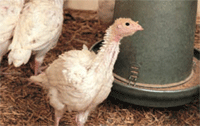



Checklist for Fly Control in Poultry Facilities
By Alberta Agriculture and Rural Development. Fly control is important in poultry facilities due to possible economic loss from increased disease spread, mortality and food safety concerns.House flies and other non-biting flies do not cause direct injury to birds but they do transfer pathogens from bird to bird within a flock or from farm to farm. Flies feed on manure and dead birds, picking up bacteria and other pathogens on their mouthparts, legs and wings. When they land on feeders and waterers, they contaminate the feed and water and pass on the pathogens.

Fly populations are a mix of various lifecycle stages (egg, larva, pupa, adult). Therefore, control methods should be conducted regularly, preferably weekly, effectively to disrupt the fly lifecycle and prevent fly outbreaks. If or when insecticides are used, birds should be removed from the area prior to application and all label instructions strictly followed. If control of adult flies is necessary in situations where birds cannot be removed, less invasive methods like fly sticky traps or container traps may be better alternatives to insecticides. Remember that control of just the adult portion of the population will only be short-term. Removal of fly breeding habitat is the key to reducing fly populations effectively.
Because of the enclosed and controlled environment of poultry houses, fly control is a year-round process. Having a written fly management plan and communicating with your neighbours about the actions you are taking to reduce fly populations on your operation will help avoid potential nuisance complaints. Taking a proactive approach to fly control is your best defence.
The following checklist is a tool for you to use in monitoring fly populations and in routine maintenance of key fly breeding habitats on your operation. :
- identify sites where flies are breeding on your operation,
- locate the potential source of a nuisance fly outbreak, or
- use as a weekly cleanup and maintenance checklist to ensure the effective control of fly populations on your operation.
Remember to keep these checklists as part of your records to confirm the action you have taken to control fly populations on your operation.
For more information regarding fly monitoring and control options, refer to the Alberta Agriculture and Rural Development publication, ‘A Guide for the Control of Flies in Alberta Confined Feeding Operations’.
Fly Monitoring
Potential fly breeding areas: Manure
- accumulated manure under caged laying hens
- accumulated manure under slats in breeder laying-hen houses
- under bedding of broiler and turkey houses
- residues of manure left by scrapers and flushing systems
- wet manure under waterers in caged layer and breeder houses
Potential fly breeding areas: Feed
- moist spilled feed
- wet litter under waterers in broiler and turkey houses
Potential fly breeding areas: Other
- dead birds*
- broken eggs
- wet areas due to surface runoff into barns and pits
- under tall grass and other vegetation immediately surrounding barns that can become moist areas with degrading plant material
Recommended Control Methods:
- proper ventilation and airflow to dry manure and bedding
- prevent leaky waterers
- remove manure frequently in scraper and flush systems
- in systems with accumulated manure, remove only once or twice per year during the cool season and leave a base of dry, absorptive old manure
- divert surface water by grading and providing drainage around barns and facilities
- keep vegetation mowed short around barns
- prevent feed spillage
- incinerate or compost dead birds immediately
- remove broken eggs
- properly maintain manure storage area and promote drying of manure
Additional Control Options:
- indoor and outdoor fly bait stations
- indoor fly sticky traps
- residual insecticide spray on adjacent vegetation and buildings
- misting for adult fly control as needed†
- treatment with larvicides‡
* Dead animals are a particular source of blow flies.
† It is important to follow all label directions for product use to ensure personal safety, the safety of others and the safety of livestock.
‡ Check with your local retailer regarding product options and product registration for use in your country.
August 2008








